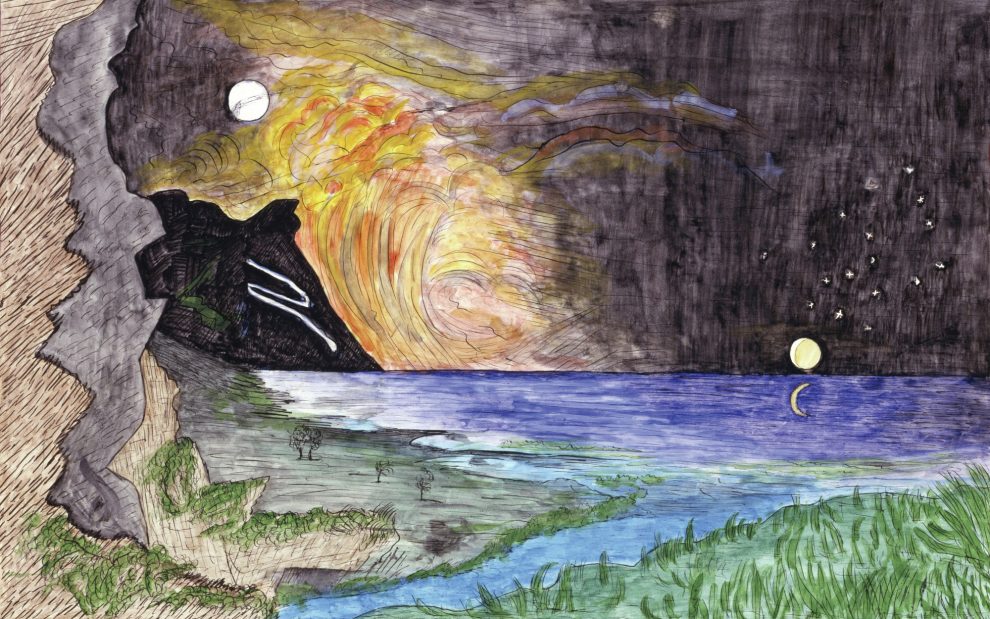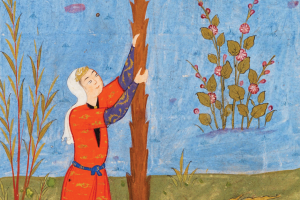A lot can be said in celebration of the binary. It’s an ancient system of organization, dividing reality into complementary or contradictory halves. Think true/false tests and yes/no answers. Arranging reality in black-and-white terms can make it as interconnected as swirls of yin and yang or as conflicted as two armies squared off on a battlefield.
Binary systems were used in China, Egypt, and India thousands of years ago in the fields of mathematics, philosophy, and literature. Binary thinking made the invention of the computer possible. The binary code is the simplest mathematical language: a tiny realm based utterly on ones and zeroes.
Many people find it efficient to keep their moral universe neatly binary. Such a perspective divides right from wrong, truth from lies, sinners from saints. It distinguishes between orthodoxy and heresy, the saved and the damned. Heaven or hell: What could be more clarifying on the moral map than this profound fork in the road?
One might argue that God is the inventor and chief proponent of binary reality. Doesn’t Genesis declare it on page one? God organizes primordial chaos into neat divisions of light and darkness, day and night, land and water, birds and fish, man and woman. Let there be order, and let it be wondrously binary!
The dualistic vision works well at certain times for certain people. Take divinely favored Israel versus the nations. If you’re Israel, this is an excellent reality to buy into. Not so much if you happen to be born in Assyria, Edom, or Egypt. Israelite binary love manifests in laws concerning diets—kosher or bacon eater?—as well as clean or unclean, holy or profane. Lines of demarcation are drawn between marriage partners, priests and the priested, landowners and workers, judges and the judged. It is always clear who counts and who belongs.
As the gospel writers keenly observe, only men are counted in a biblical crowd. Women and children are merely presumed. In systems comprising ones and zeroes, it’s always great to be a one and rotten if you’re a zero.
There are holes in any plotline narrated about scripture. While it’s true that elements are separated dualistically on most days of creation, we have to reckon with that wild and crazy sixth day when God makes all the land creatures at once. Nothing binary about lions and tigers and bears, oh my! Truth be told, not much is dualistic about the fifth day either, when birds and fish fill skies and oceans. Some birds swim, and some fish fly. Amphibious creatures squirm in the between spaces, ambiguously depending on water and air. And what about the sea monsters also created on day five? Birds, fish—and sea monsters? Suddenly a trinity stirs where a duality might have appeared to be.
It’s as if God gets bored with drawing a line down the middle of things after a few days and decides to have some fun.
Advertisement
It’s as if God gets bored with drawing a line down the middle of things after a few days and decides to have some fun. Then again, maybe blurring the binary was the original plan. Days and nights enjoy fuzzy transitional moments we call dawn and dusk. Swamps are neither dry land nor lakes, necessitating the curious term wetland. While on the fourth day God establishes a sky dome intended to separate the heavens from the earth, we humans blew past that a while ago. Please note: On that same extraordinary day God determines to play outside the binary sandbox entirely and make the earth a zootopia, God also creates human beings.
The Genesis writer takes pains to describe the uniqueness of these lone creatures who bear the divine image. They represent perhaps the greatest binary: not maleness and femaleness but rather the division between a species bearing God’s likeness and all the rest. God’s creatures are all wondrous, strange, delightful, and surprising. All are necessary to the fullness of creation, from amoebas and spiders to buffalo and orangutans. The human animal alone possesses the Creator’s imprint.
Affection for the binary continues into Noah’s time, as animals present themselves two by two to board the ark. So says Genesis 6, anyway. In the second verse in Chapter 7, clean animals arrive in seven coupled sets while the unclean are in single pairs. Even in this numerical imbalance, duality is maintained: the favored and the less favored. Noah’s family numbers eight members, also in mated pairs.
Genesis maintains its love affair with the binary code through its stories of brothers: Cain and Abel, Esau and Jacob, Ishmael and Isaac. Knowing the code, we can guess which brother was born to be a zero. While creation’s original design may have included a yin-yang swirl, such complementarity drains from the system at the same hour sin moves in.
Any charm in the binary goes dark after the expulsion from Eden when the male assumes dominion over the female. Weren’t both equal bearers of God’s image? Yet one gains ascendancy and quickly institutionalizes it. If pride is the first sin, patriarchy is the second.
If pride is the first sin, patriarchy is the second.
The binary as simple complementarity (sun and moon, male and female) takes a sinister turn into the contest (Cain versus Abel, Ishmael versus Isaac). In each biblical bro-pairing, only one can have primacy. The urgency to rank, demean, exclude, and even destroy the other isn’t in the original blueprint. The Creator never suggests that land and water duke it out until one remains. All is declared good once. It must have been nice. We can only imagine a world without hierarchy, power struggles, and prejudice, where no side has to lose.
The thread of the now sinister story of the binary winds through eras of kings and armies, marriages and ideologies, walls and excommunications. Sooner or later, however, we must come to terms with St. Paul and his astounding erasure of ones and zeroes in Galatians 3: In Christ, St. Paul insists, there is no male or female, Jew or Greek, slave or free. He even extends that erasure in Ephesians 2, negating the distinction of circumcision and uncircumcision. Erasing that mark of the covenant between Israel and God was an audacious move in a young church that still identified as a sect within Judaism. St. Paul is, in a sense, bringing the siblings back together. Cain and Abel have had their quarrel about ritual outcomes. Done. Now let’s be family again.
As the hymn goes, in Christ there is no east or west. Pope Paul VI proved it when he met with Patriarch Athenagoras of Constantinople in Jerusalem in 1964—the first time the churches of the East and West put their differences aside since the mutual excommunications of 1054. Sometimes it takes a millennium to put things in perspective. East and West were finally ready to make the joint statement that “they regret the offensive words, the reproaches without foundation, and the reprehensible gestures.” Good start. And then: “They likewise regret and remove both from memory . . . the sentences of excommunication which . . . has hindered closer relations in charity; and they commit these excommunications to oblivion.”
To oblivion? The church can do this: consign wrong thinking to oblivion. We don’t have to continue to justify and compound past errors just because they’re on the books. We can “remove both from memory” that which hinders charity. If we the church would claim this prerogative more, just dream of the possibilities.
This article also appears in the October 2021 issue of U.S. Catholic (Vol. 86, No. 10, pages 47-49). Click here to subscribe to the magazine.
Image: Lawrence W. Ladd, The Creation, ca. 1880, watercolor on paper, Smithsonian American Art Museum












Add comment